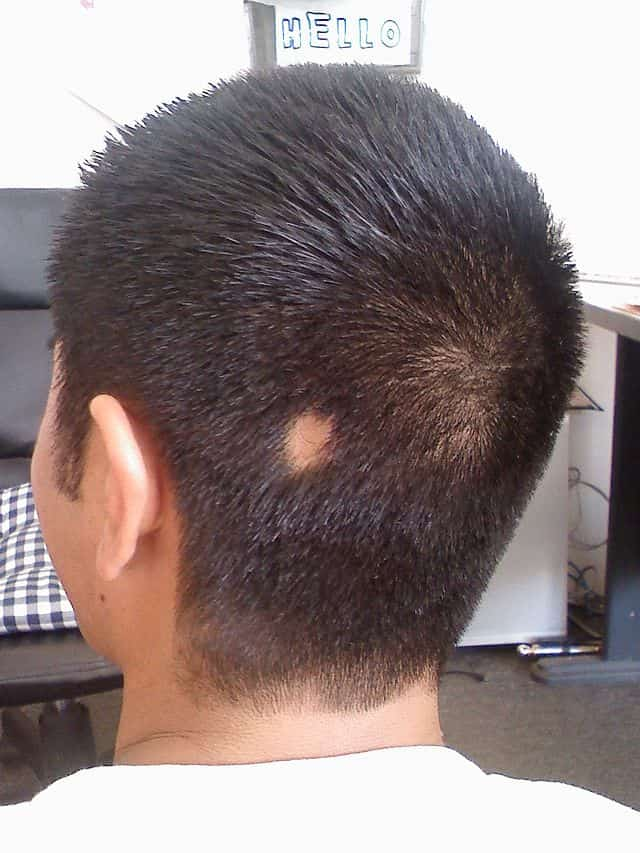Vitiligo – an autoimmune condition that attacks the melanocytes in the skin – doesn’t cause hair loss on its own. However, it can indirectly lead to different types of alopecia.
It’s not that vitiligo doesn’t affect the hair at all. This condition can also affect the pigmentation of the hair, making it turn white or grey. Even so, this isn’t what causes hair loss.
Being an autoimmune condition, it has a tendency to occur with other autoimmune conditions. While that’s one of the biggest reasons why it causes hair loss, there are others as well.
Fortunately, there are treatments that can help you with both vitiligo and its related hair loss. Read on to learn more about vitiligo hair loss and what you can do about it.
Can Vitiligo Cause Hair Loss?
Vitiligo does not cause hair loss. However, you can experience hair loss with vitiligo due to other autoimmune conditions, a side effect of medications, and stress.
Keep in mind that vitiligo is an autoimmune condition that destroys the cells that produce and contain the pigment melanin. As a result of this, the skin (and hair) ends up losing its colour.
While this condition doesn’t threaten the physical health of the individual, it can be very distressing, especially since it can also affect the ethnic identity of an individual.
How Vitiligo Causes Hair Loss?
To understand how vitiligo can indirectly cause hair loss, let’s take a closer look at each of the main reasons.
Other Autoimmune Conditions
According to MedlinePlus, 15%-25% of the people with vitiligo also have other autoimmune conditions, such as:
These “other” autoimmune illnesses that tend to coexist with vitiligo can end up causing hair loss in different ways.
For instance, Celiac disease can cause nutritional deficiency (among other problems), which interferes with hair growth. Similarly, the itching caused by psoriasis can also lead to hair loss due to scratching the head.
Other than these, there are many reports of vitiligo occurring together with alopecia areata. They can even occur together at the exact same spot on the skin. So there’s depigmentation and loss of hair in the particular patch.
Keep in mind that vitiligo and alopecia areata are different conditions. Alopecia areata is an autoimmune condition that causes patchy hair loss (or, in more severe cases, hair loss on the entire body). Vitiligo, on the other hand, forms pale white patches on the skin.

However, a study published in the Journal of the American Academy of Dermatology reported that vitiligo has a 3%-8% prevalence rate in patients with alopecia areata.
So, it’s not simply random. That’s because it’s hypothesised that they both have similar “pathogenesis” (origins and disease development).
Here, it’s also interesting to note that certain medications (like diphencyprone) used to treat alopecia areata can also induce vitiligo.
Moreover, vitiligo is also associated with even more autoimmune conditions like lichen planus, Sjögren’s, thyroiditis, and Addison’s, among others.
Side Effect of Medication
Some of the medications used for the treatment of vitiligo can also cause hair loss.
For instance, corticosteroids can be prescribed to slow or reverse vitiligo. However, some corticosteroids can also cause hair loss.
Prednisolone is one example of it, and it can possibly cause shedding and thinning of hair.
Stress
Vitiligo is not a life-threatening condition. Even so, it can have a significant impact on the mental health of the individual because of the changes in their appearance.
According to a study published in the International Journal of Women’s Dermatology, vitiligo can cause:
- Depression
- Isolation
- Stigmatisation
- Loss of self-esteem
- Self-consciousness
You might also feel angry and embarrassed, especially in social situations. And it can also cause anxiety.
These emotional stressors can trigger a type of hair loss known as telogen effluvium.
What Is Vitiligo Hair Loss Treatment?
The treatment for vitiligo hair loss will depend on the type of hair loss you’re experiencing.
If it’s vitiligo and alopecia areata, you might be prescribed JAK (Janus Kinase) inhibitors. These are types of drugs that have been used in the treatment of different inflammatory conditions.
These have also been used to treat vitiligo and alopecia areata separately. Ruxolitinib got FDA approval in 2022 for the treatment of vitiligo. And in the same year, another JAK inhibitor baricitinib was also approved for the treatment of alopecia areata.
If hair loss is the side effect of your medication, you should consider consulting your doctor about it (don’t discontinue your medication without consulting your doctor). They may recommend an alternative.
As far as telogen effluvium is concerned, this type of hair loss doesn’t require any treatment. It can reverse on its own.
Is Vitiligo Hair Loss Reversible?
With treatment, your vitiligo hair loss is likely to be reversible. The treatment for vitiligo can also restore the pigmentation of your hair.

In the meantime, it’s a good idea to practise gentle hair care. For instance, research reports that hair dyes can increase the risk of developing vitiligo, so you should avoid using them.
Conclusion
More often than not, vitiligo is considered a “cosmetic problem.” However, in truth, it’s a medical condition that can seriously impact a person’s quality of life. And the hair loss associated with it can only worsen things.
While this condition doesn’t cause hair loss, it can indirectly lead to alopecia. More commonly, it’s due to the alopecia areata that’s associated with it.
If you’re experiencing patchy (or diffuse) alopecia, make sure to consult a board-certified medical professional. There are many different types of hair loss, and you need an accurate diagnosis before starting any treatment.



